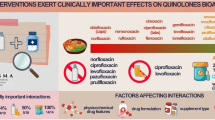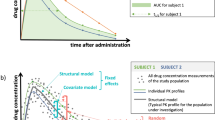Abstract
Objective: To evaluate the dose proportionality and linearity and pharmacokinetic profile of desloratadine after single oral doses over the range of 5 to 20mg.
Design: Single centre, randomised, open-label, 4-way crossover study in which healthy adults received single doses of desloratadine (5, 7.5, 10 and 20mg) in 4 different treatment periods. Desloratadine was administered each morning after a 10-hour fast. A washout period of at least 14 days separated each dose. Plasma concentrations were measured prior to each treatment and over the 168 hours after drug administration to determine the area under the plasma concentration-time curve (AUC) and maximum observed plasma concentration (Cmax).
Participants: 20 healthy male volunteers (3 White, 17 Black) ranging in age from 19 to 45 (mean 37) years and weighing 54 to 91 (mean 75) kg were enrolled and completed this study.
Main outcome measures: The primary parameter to assess dose proportionality and linearity was AUC from time zero to final concentration time point (AUCs).
Results: The Cmax for all doses was observed approximately 4 hours after administration, revealing no dose-related differences in absorption rate. The half-life (t1/2) ranged from 21.2 to 24.1 hours. Cmax and AUCs increased in a doseproportional manner over a dose range of 5 to 20mg. Although the recommended clinical dose is 5mg, doses up to 20mg were well tolerated.
Conclusion: In this study, single doses of desloratadine as high as 4 times the recommended clinical dose of 5mg were well tolerated. The Cmax and AUCs for doses of 5 to 20mg increased in a dose-proportional manner.




Similar content being viewed by others
References
Benet LZ, Kroetz DL, Sheiner LB. Pharmacokinetics: the dynamics of drug absorption, distribution, and elimination. In: Hardman JG, Limbird LE, Molinoff PB, et al., editors. Goodman & Gilman’s the pharmacological basis of therapeutics, 9th ed. New York: McGraw-Hill; 1996: 3–27
DuBuske L. Second-generation antihistamines: the risk of ventricular arrhythmias. Clin Ther 1999; 21; 281–95
Richens A. Clinical pharmacokinetics of phenytoin. Clin Pharmacokinet 1979; 4: 153–69
Meltzer EO, Prenner BM, Nayak A. Efficacy and tolerability of once-daily 5mg desloratadine, an H1-receptor antagonist, in patients with seasonal allergic rhinitis. Assessment during the spring and fall allergy seasons. Clin Drug Invest 2001; 21(1): 25–32
Gibaldi M, Perrier D. Pharmacokinetics. 2nd ed. New York: Marcel Dekker, 1982
Acknowledgements
Supported by a research grant from Schering-Plough Research Institute, Kenilworth, New Jersey.
Author information
Authors and Affiliations
Rights and permissions
About this article
Cite this article
Gupta, S., Banfield, C., Affrime, M. et al. Desloratadine Demonstrates Dose Proportionality in Healthy Adults After Single Doses. Clin Pharmacokinet 41 (Suppl 1), 1–6 (2002). https://doi.org/10.2165/00003088-200241001-00001
Published:
Issue Date:
DOI: https://doi.org/10.2165/00003088-200241001-00001




